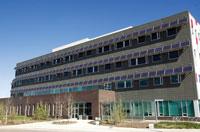
An organization’s contributions to society are judged on more than the basis of the quality of goods and services produced. Today, the care shown to employees and the environment is just as important. Over the past decade, many companies and individuals have come to realize that, collectively, we are the stewards of the environment. Finding and maintaining harmony between the built and natural environments is the hallmark of sustainability.
The responsibility for stewardship and sustainability belongs to all users of a facility and its grounds. Many companies and organizations have spent the last decade working toward reducing costs, improving employee satisfaction, promoting corporate responsibility and environmental stewardship, and improving sustainability performance.
 One of the most visible things an organization can do to demonstrate its commitment to environmental stewardship and sustainability is to locate in a high-performance, certified green building. A 2010 survey conducted by CoreNet Global and Jones Lang LaSalle found that sustainability is a key factor in space occupancy planning for global companies. Half of the companies surveyed stated that they would pay higher rates for space in a green building.
One of the most visible things an organization can do to demonstrate its commitment to environmental stewardship and sustainability is to locate in a high-performance, certified green building. A 2010 survey conducted by CoreNet Global and Jones Lang LaSalle found that sustainability is a key factor in space occupancy planning for global companies. Half of the companies surveyed stated that they would pay higher rates for space in a green building.
However for those currently in a long-term lease or in a prime location, this may not be feasible. Executives looking to expand their building stock would do well to consider the many environmentally-friendly operational and maintenance practices that can be implemented in existing buildings to reduce the negative impact of human and business actions on the environment. These sustainable practices include energy savings, waste stream reduction and increases in productivity.
The majority of existing buildings were not designed for energy efficiency. Through the use of green maintenance and operations strategies—including systems and technologies — significant energy savings can be realized. A study conducted by the International Facility Management Association in 2010 showed that 60 percent of respondents planned to upgrade energy efficiency by making improvements and investments in their buildings. Facility managers are in the unique position to be environmental stewards of the physical workplace as they have the knowledge and ability to upgrade equipment and daily operations of a building to be more cost and energy efficient.
Education
In order to achieve market transformation in existing buildings, facility professionals need the education and tools to create a sustainable facility management program that has all of the right elements custom-fitted to their organization. Organizations such as IFMA are committed to providing the education, training and resources for facility managers to sustainably manage, operate and maintain their assets. IFMA was founded in 1980 and is the leading global non-profit organization for professional facility managers supporting over 19,000 members in 78 countries.
Because most occupants consider a high-performance building stock desirable, continuing the education of the facility management professionals who operate and maintain our aging buildings is the most effective way to create facilities that meet the organizational mission, social responsibility and environmental goals of the businesses they serve.
The passage of the Federal Buildings Personnel Training Act of 2010 highlighted the importance of continuing education in facility management. This recent legislation requires all federal facility managers to exhibit proficiency in facility management — including the arenas of energy efficiency, safety and the creation of productive work environments — by completing certified education and credentialing programs.
This is in line with a credential program targeting sustainable facility management that has been launched by IFMA. The Sustainability Facility Professional credential joins two leading accredited certifications that have served the facility management profession for nearly 20 years, the Facility Management Professional and the Certified Facility Manager.
The SFP certification is designed to empower facility managers to choose the techniques and practices that will custom fit their organization. This sustainability education emphasizes the operational practices of buildings and provides facility managers with the practical tools and best practices they need to be successful. In turn, a facility manager with the knowledge and skills to assess and implement sustainable building practices positively impacts the environment as well as the organization’s bottom line. The hope is that every facility management professional will actively engage in sustainable practices not only in the workplace, but also in the communities in which they live and serve.
To learn more about IFMA’s educational programs, please visit www.ifma.org/learning.
The Business Case
Aging buildings have been and will continue to be an ongoing challenge for facility professionals and building owners. Especially in the current economic climate, shrinking capital and operational budgets can make implementing sustainable practices difficult, even though the cost differential may be minimal. At the same time, sustainability and social responsibility are becoming more closely integrated into the practices of the facility manager who is responsible for the daily operations of the facility. Also increasing in importance are the arenas of energy conservation, resource management and improvements to the work environment.
When considering if future space needs will be best met by reconfiguring current space, leasing additional space or building a new facility, executives looking to do expansion planning will be well served to consider sustainable facility management as an additional asset. Strategic facility plans can make the business case for investments in sustainability-related initiatives. In addition to green building technologies and systems, rearranging work space to include offices and workstations installed on a grid using modular walls integrated with an electrical and data grid can allow for easy reconfiguration. These lightweight partitions can create floor-to-ceiling privacy for conventional office space, yet unlike traditional permanent walls, can allow for a floor layout to be reconfigured with minimum disruption and little-to-no waste.
When new construction is not on the agenda, green retrofits can also help facilities achieve a sustainable future. Even small improvements can make a significant change in energy efficiency and the bottom line. This includes lighting, which is a significant energy consumer. Operational practices such as turning off lights in unoccupied areas, increasing and maximizing daylighting, using lighting controls and converting to more efficient bulbs all make a difference. These are but a few of the sustainable improvements that can be made by a facility manager to maximize the efficiency of a building.
Looking Forward
Sustainable facilities are here to stay, and that makes not only environmental, but economic and social sense. According to the Brookings Institution, by 2030 approximately half of the building stock in the U.S. will have been built after 2000. While many of the buildings constructed in the past decade have incorporated sustainable practices, there are still millions of square feet in existing buildings to be renovated, operated and maintained in a sustainable manner.
Economic pressures and upcoming sustainability requirements are driving companies to identify projects that will improve the triple bottom line. IFMA is committed to the integration of sustainability into the facility management process as part of the overall real estate strategy plan of a company. This is a natural fit as sustainable facility management allows an organization to build, operate and maintain facilities that meet organizational goals, provide a productive workplace and have a minimal impact on the environment.
About the International Facility Management Association (IFMA)
IFMA is the world’s largest and most widely recognized international association for professional facility managers, supporting more than 19,000 members in 78 countries. The association’s members, represented in 124 chapters and 16 councils worldwide, manage more than 37 billion square feet of property and annually purchase more than US $100 billion in products and services. Formed in 1980, IFMA certifies facility managers, conducts research, provides educational programs, recognizes facility management certificate programs and produces World Workplace, the world’s largest facility management conference and exposition. To join and follow IFMA’s social media outlets online, visit the association’s LinkedIn, Facebook, YouTube and Twitter pages. For more information, visit www.ifma.org.


